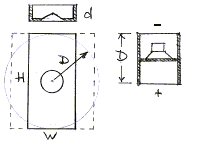I've been thinking about making some dipole baffles for the bass end of my system for some time now, but there's one question I'd like to ask, that I haven't seen others pose yet...
...Does a H frames wings/flares(bits coming forward and backward off the baffle)significantly lower the point where the open baffle design starts to roll off?
I chose the H frame design, because I'm trying to get as high as possible without problems from baffle resonance, do the wings of a H frame lower the roll off point a lot or would someone like myself be better off going with just a flat baffle type of design?
...Does a H frames wings/flares(bits coming forward and backward off the baffle)significantly lower the point where the open baffle design starts to roll off?
I chose the H frame design, because I'm trying to get as high as possible without problems from baffle resonance, do the wings of a H frame lower the roll off point a lot or would someone like myself be better off going with just a flat baffle type of design?
When people design a H frame, most constructions seem to end up with a frame about as wide as deep. So most frames with an effective depth "D" are "D" wide also.
A rectangular flat baffle with an effective radius "D" can be made a bit smaller than 2*D. My estimation: The front silhouette of a flat baffle needs to be at least 1.5 times wider than an equivalent H frame.
The sketches I "borrowed" from Linkwitz´side hopefully illustrate what I mean.
Regarding "because I'm trying to get as high as possible without problems from baffle resonance":
The lambda/4 resonance of a H frame (which has to be cared for/equalized) is NOT determined by the depth D alone, but heavily influenced by the driver too. Please read all about it in: http://www.linkwitzlab.com/faq.htm#Q28
So if you are lucky the resonance peak may be outside your (extended?) passband. If you are not, it might cut your passband beyond a point you are willing to accept.
Rudolf
A rectangular flat baffle with an effective radius "D" can be made a bit smaller than 2*D. My estimation: The front silhouette of a flat baffle needs to be at least 1.5 times wider than an equivalent H frame.
The sketches I "borrowed" from Linkwitz´side hopefully illustrate what I mean.
Regarding "because I'm trying to get as high as possible without problems from baffle resonance":
The lambda/4 resonance of a H frame (which has to be cared for/equalized) is NOT determined by the depth D alone, but heavily influenced by the driver too. Please read all about it in: http://www.linkwitzlab.com/faq.htm#Q28
So if you are lucky the resonance peak may be outside your (extended?) passband. If you are not, it might cut your passband beyond a point you are willing to accept.
Rudolf
Attachments
- Status
- This old topic is closed. If you want to reopen this topic, contact a moderator using the "Report Post" button.
